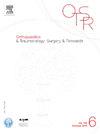Results of the Girdlestone Procedure for the Treatment of Refractory Hip Prosthesis Infections
IF 2.2
3区 医学
Q2 ORTHOPEDICS
引用次数: 0
Abstract
Introduction
Refractory prosthetic joint infections (PJI) of the hip remain a major challenge in orthopedic surgery. The Girdlestone procedure, also known as resection arthroplasty, was originally described for native hips but has since been adopted as a salvage option for complex and recurrent prosthetic infections. The main objective of this study was to evaluate the effectiveness of this procedure in treating prosthetic hip infections in this context.
Materials and methods
Eighty-eight patients (91 hips) who underwent femoral resection arthroplasty for refractory hip prosthesis infection between March 2004 and August 2019 were retrospectively included and analyzed as part of a single-center study with a minimum follow-up of two years. The primary outcome was infection eradication. Secondary outcomes included the incidence of treatment failure and the nature of postoperative complications. Risk factors for failure were identified using a Cox proportional hazards model. Bacteriological data and functional outcomes were also reported.
Results
Out of 91 hips, infection eradication was achieved in 65 cases (71%) following Girdlestone procedure. Six postoperative deaths related to infection occurred (6/88, 7%). In 20 out of 91 hips (22%), one or more revision surgeries were performed for persistent infection after implant removal. Among these, infection control was achieved in 10/20 (50%). Multivariate analysis identified corticosteroid use (HR = 6; p < 0.01), preoperative fever (HR = 4.12; p < 0.01), and polymicrobial infection (HR = 2.5; p < 0.05) as independent risk factors for failure. The mean limb shortening was 5.7 (±1.7) cm, and the average walking distance was 175 (±350) meters. The mean Merle d’Aubigné and Postel score at final follow-up was 9.3 (±2.2) out of 18.
Conclusion
Definitive removal of the hip prosthesis remains a viable therapeutic option in refractory infections, despite a substantial complication rate. It should be considered, particularly when the prosthesis is no longer functional.
Level of evidence
IV; Retrospective case series.
girlestone手术治疗难治性髋关节假体感染的结果。
髋关节难治性假体关节感染(PJI)仍然是骨科手术的主要挑战。Girdlestone手术,也被称为关节置换术,最初被描述为原生髋关节,但后来被采用作为复杂和复发性假体感染的补救选择。本研究的主要目的是评估在这种情况下这种手术治疗假髋关节感染的有效性。材料和方法:回顾性纳入2004年3月至2019年8月期间因难治性髋关节假体感染接受股骨切除术置换的88例患者(91髋),并作为至少随访两年的单中心研究的一部分进行分析。主要结果是感染根除。次要结局包括治疗失败的发生率和术后并发症的性质。使用Cox比例风险模型确定失败的危险因素。还报道了细菌学数据和功能结果。结果:在91例髋关节中,65例(71%)采用Girdlestone手术根除感染。6例术后死亡与感染有关(6/ 88,7%)。在91例髋关节中,有20例(22%)因植入物取出后持续感染进行了一次或多次翻修手术。其中10/20例(50%)感染得到控制。多变量分析确定皮质类固醇使用(HR = 6;结论:尽管难治性感染的并发症发生率很高,但髋关节假体的最终移除仍然是一种可行的治疗选择。这应该被考虑,特别是当假体不再具有功能时。证据等级:四级;回顾性病例系列。
本文章由计算机程序翻译,如有差异,请以英文原文为准。
求助全文
约1分钟内获得全文
求助全文
来源期刊
CiteScore
5.10
自引率
26.10%
发文量
329
审稿时长
12.5 weeks
期刊介绍:
Orthopaedics & Traumatology: Surgery & Research (OTSR) publishes original scientific work in English related to all domains of orthopaedics. Original articles, Reviews, Technical notes and Concise follow-up of a former OTSR study are published in English in electronic form only and indexed in the main international databases.

 求助内容:
求助内容: 应助结果提醒方式:
应助结果提醒方式:


